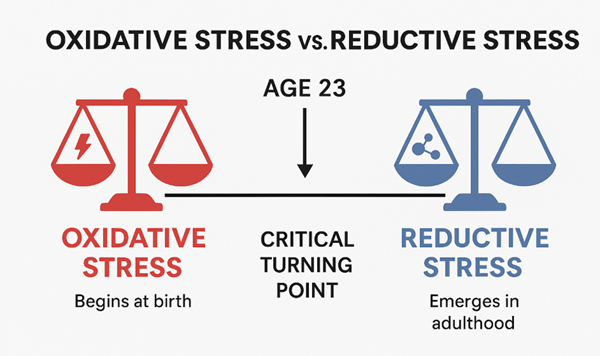Metabolic Therapy: A New Approach to Supplementation
What if the very supplements you’ve been told will keep you young are actually speeding up your aging process? A groundbreaking discovery in gerontology research has revealed exactly that. Scientists have identified a second aging pathway that exposes a hidden danger: too many antioxidants can actually accelerate aging.
The Quantum Leap: Oxidative vs. Reductive Stress
Until recently, nearly all aging research focused on oxidative stress (OxS) — the cellular damage caused by reactive oxygen species (ROS). This process, which begins at conception, disrupts immune, nervous, and hormonal systems and has long been blamed as the primary driver of aging.
But now, researchers have uncovered a second, aging pathway: reductive stress (RedS) a state caused by an overabundance of reducing molecules, often from excessive antioxidant intake. Instead of protecting cells, this imbalance disrupts mitochondrial signaling, impairs repair mechanisms, and accelerates tissue breakdown.
Think of your cells as a seesaw. On one side is oxidative stress; on the other, reductive stress. When the seesaw tips too far in either direction, the delicate balance of life begins to break down.
The Age 23 Biological Shift
 The real surprise? Reductive stress doesn’t kick in at birth. Research shows a critical turning point around age 23, when we reach biological maturity. Up until this age, oxidative stress dominates. But after 23, the balance shifts — and reductive stress becomes the main driver of aging decline.
The real surprise? Reductive stress doesn’t kick in at birth. Research shows a critical turning point around age 23, when we reach biological maturity. Up until this age, oxidative stress dominates. But after 23, the balance shifts — and reductive stress becomes the main driver of aging decline.
This means the “antioxidant loading” strategy that protects us in youth may become harmful in adulthood. Too much of a good thing can, quite literally, tip the scale toward faster aging.
The Antioxidant Myth: Why More Isn’t Always Better
For decades, supplementation advice was built on the idea that more antioxidants meant more protection. But the discovery of RedS shows that excessive antioxidant intake can:
- Suppress critical cellular signaling pathways
- Impair mitochondrial energy production
- Accelerate the onset of cellular senescence (zombie cells)
- Shorten both healthspan and lifespan
This doesn’t mean antioxidants are bad — it means balance is everything. The key is not flooding the system, but maintaining a delicate equilibrium between oxidation and reduction.
This discovery highlights the critical need for personalized, stage-specific supplementation — not a generic, one-size-fits-all strategy. What may be beneficial at age 18 can become detrimental by age 40 if biochemical balance shifts are ignored. This principle forms the foundation of what we refer to as a “Stage of Life Nutritional Approach.”
Metabolic Therapy: A New Model for Longevity
This research has given rise to metabolic therapy — a science-backed approach to supplementation designed to restore cellular balance, not overload it. Instead of ‘megadosing’ antioxidants, metabolic therapy focuses on:
- Supporting mitochondrial resilience
- Optimizing DNA repair
- Modulating both oxidative and reductive stress in harmony
It represents a shift from the old “more is better” mindset to a precision-guided, balanced approach.
Introducing Rejuvenins: The Future of Anti-Aging Science
Perhaps the most exciting outcome of this research is the discovery of Rejuvenins — a new class of nutrients shown to enhance mitochondrial health, repair genetic damage, and rebalance oxidative and reductive pathways simultaneously. These compounds are emerging as a potential game-changer in extending not just lifespan, but vital, functional years. For decades, anti-aging strategies focused on slowing decline. Rejuvenins represent something entirely new: a path toward cellular renewal — not just preservation.
At Sparling Chiropractic, we integrate these cutting-edge findings into a personalized, whole-body approach to longevity — helping patients protect their metabolic balance and optimize the body’s natural repair systems at every stage of life.
Stay tuned: Our next post will dive into the nutrients recommended for our SOLID Plan. (Stage of Life Inflammaging Plan)
References & Resources:
- Maity, S., et al. “Reductive Stress: Revisiting the Mechanism of Oxidative Stress.” Free Radical Biology & Medicine (2020).
- Rajasekaran, N. S., et al. “Reductive stress and its role in aging and cardiovascular disease.” Antioxidants & Redox Signaling (2011).
- Lushchak, V. I. “Disbalance of Oxidants and Antioxidants: Oxidative and Reductive Stress.” Chemico-Biological Interactions (2014).
- Chandra, A., et al. “Reductive stress, a new paradigm in aging research: Implications for mitochondria and metabolic therapy.” Aging Research Reviews (2021).
- de Cabo, R., & Mattson, M. P. “Mitochondrial adaptation and hormesis in aging and disease.” Nature Reviews Molecular Cell Biology (2019).
- Lee, B. C., et al. “Rejuvenins: Emerging Nutrients for Mitochondrial Health and Longevity.” Journal of Geroscience Research (2023).
By Dr. Sparling
‹ Back









